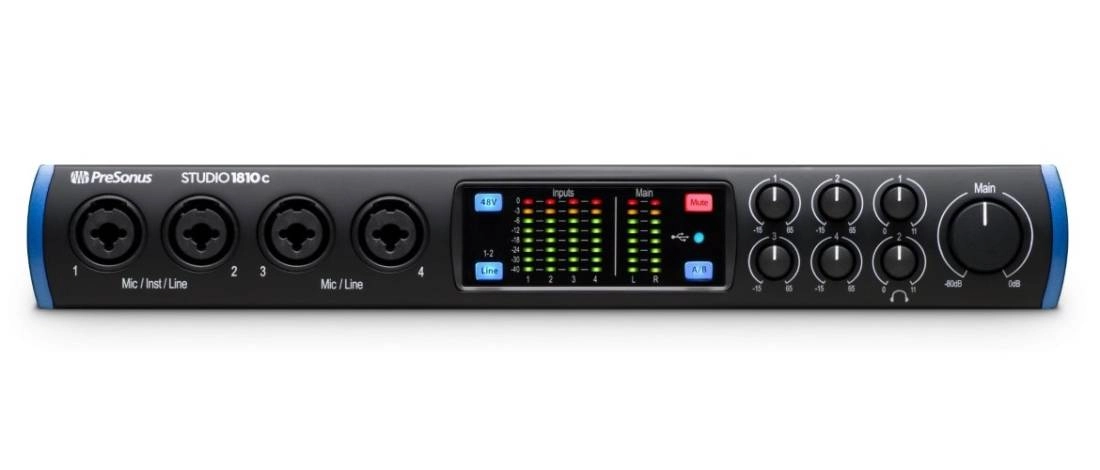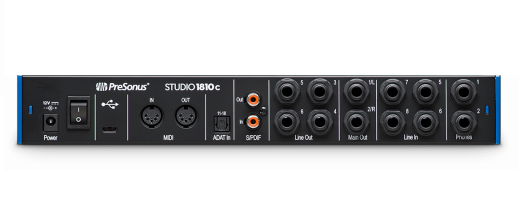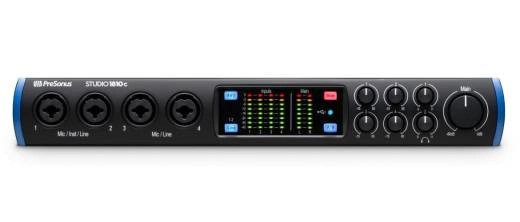PreSonus Studio 1810c 18 entrées / 8 sorties 192 kHz Interface audio USB-C

Photos additionnelles :

Vidéos :

Idéal pour les producteurs et les petits groupes qui veulent enregistrer de l'audio à partir d'un large éventail de sources. Le Studio 1810c est un ensemble d'enregistrement complet et tout-en-un qui offre une intégration en salle de contrôle avec le logiciel de production musicale Studio One Artist inclus et le logiciel de contrôle de surface UC gratuit. Il est rétrocompatible avec les connexions USB 2.0 et 3.0.
L'interface audio Studio 1810c 18 entrées et 8 sorties dispose d'une connectivité informatique USB-C et enregistre jusqu'à 18 entrées simultanées, dont 4 entrées micro avec préamplis micro XMAX, 4 entrées ligne spécialisées, 8 entrées optiques ADAT (4 canaux à 96 kHz) et des entrées S/PDIF. En plus des sorties G/D principales, vous obtenez quatre sorties de niveau ligne couplées en courant continu qui peuvent envoyer des tensions de commande. Vous disposez également de deux sorties casque avec commutation A/B pour la surveillance de différents flux de mixage. Une interface MIDI intégrée permet la connexion à un clavier, un module de son ou une surface de contrôle.
Caractéristiques
Entrées/sorties
- E/S simultanées jusqu'à 18 entrées/sorties (8x6 à 192 kHz)
- 2 entrées micro/instrument/ligne avec préamplis micro XMAX classe A
- 2 entrées micro/ligne avec préamplis micro XMAX classe A
- 4 entrées ligne symétriques 1/4" TRS direct vers ADC
- 8 canaux d'entrée optique ADAT (4 canaux à 96 kHz)
- 2 sorties principales symétriques 1/4" TRS
- 4 sorties ligne TRS 1/4" symétriques pour le mixage de monitoring
- 2 sorties casque stéréo avec le même mixage ou des mixages indépendants
- Entrée/sortie MIDI
- E/S numérique S/PDIF stéréo S/PDIF
- 1 port USB-C 2.0
Logiciel intégré
- Studio One Artist pour Mac et Windows
- Logiciel de contrôle de surface UC pour Mac, Windows, iPad et Android
- Studio Magic Plug-in Suite
Compteurs, commandes et caractéristiques
- Mélangeur de retour DSP 18x6 intégré
- Réglages de sourdine et de niveau en face avant pour les sorties principales
- Véritable alimentation fantôme +48V pour microphones à condensateur (global)
- 6 indicateurs de niveau à 8 DEL de type échelle (4 entrées, 2 sorties principales)
Physique
- Construction robuste avec châssis entièrement en métal et boutons en métal
- Dimensions (H x P x L) : 44 mm x 317 mm x 140 mm (1,75" x 12,5" x 5,5")
- Poids : 1,45 kg (3,2 lb)
Media
Q et R
Avis

Protégez votre investissement avec la Garantie de fiabilité Long & McQuade.
Une bonne garantie est souvent un facteur décisif au moment d’un achat. Étant donné qu’une réparation peut être très dispendieuse, les manufacturiers n’offrent en général qu’une protection limitée d’un an couvrant seulement les défauts de fabrication. Lors d’une acquisition aussi importante que celle d’un instrument de musique ou d’une pièce d’équipement, vous voudrez avoir l’assurance que votre achat sera protégé de façon adéquate.
C’est pourquoi Long & McQuade offre une année GRATUITE de sa Garantie de fiabilité sur la plupart de ses produits. Cette couverture, qui bonifie celle du fabricant, vous procurera la tranquillité d’esprit que vous recherchez.
En quoi la garantie Long & McQuade se distingue-t-elle de celles des autres fabricants?
- Fiabilité assurée : l’usure normale de certaines pièces est couverte. Le produit fonctionnera aussi bien qu’au premier jour pour toute la durée de la protection. Pour les instruments d’orchestre, nos techniciens et techniciennes évalueront la nécessité d’effectuer un nettoyage en profondeur, un remplacement de tampons ou un nettoyage à ultrasons. Ces services ne sont pas offerts systématiquement dans le cadre de la Garantie de fiabilité.
- Possibilité de remplacement : si votre produit est irréparable ou coûte trop cher à remettre en état, nous l’échangerons contre un modèle identique ou équivalent, sans frais supplémentaires. Si ce n’est pas possible, nous vous accorderons un remboursement complet.
- Politique anticitron : si votre article présente un problème récurrent, nous le remplacerons.
- Accessibilité : vous pouvez vous prévaloir de votre garantie dans n’importe quelle succursale Long & McQuade.
- Réglage de guitare : une mise au point gratuite est incluse à l’achat de toute guitare neuve ou d’occasion.
- Prêt de matériel : un produit de rechange peut être mis à votre disposition pendant la réparation de votre article.
- Survoltage couvert : l’appareil est garanti même s’il est endommagé par une surtension.
- Assurance-accessoires : tous les accessoires fournis avec le produit (pédale, étui, etc.) sont couverts.
- Usage commercial approuvé : l’équipement acheté pour une utilisation intensive bénéficie aussi de cette protection.
Achat d’années additionnelles de garantie
Certains fabricants offrent une garantie de plus d’un an, mais qui est en général limitée et moins avantageuse que la nôtre. Lorsque c’est le cas, la prolongation de notre protection vous sera tout de même profitable, du fait qu’elle est plus complète et pratique.
Vous pouvez acheter des années supplémentaires de notre protection si vous souhaitez en profiter plus longtemps. Les tarifs sont les suivants :
- Produits NEUFS : à partir de 4 % du prix actuel de l’article à l’état neuf par année supplémentaire.
- Produits D’OCCASION : à partir de 4 % du prix actuel de l’article à l’état neuf pour passer initialement de trois mois à un an. À partir de 4 % pour chaque année de plus.
- Guitares : 4 % du prix actuel de l’article à l’état neuf pour passer d’un an à deux. 4 % pour chaque année de plus. Tarif maximum de 45 $. Une mise au point gratuite supplémentaire n’est pas incluse avec l’achat d’années de couverture additionnelles.
- Instruments d’orchestre : 4 % du prix actuel de l’article à l’état neuf pour passer d’un an à deux. 4 % pour chaque année de plus.




